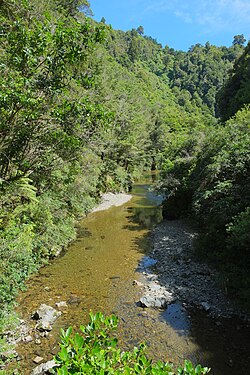Akatarawa River
Appearance
| Akatarawa River | |
|---|---|
 Akatarawa River in Akatarawa Forest | |
 | |
| Etymology | From Māori: aka (vine) and tarewa (hanging or drooping)[1] |
| Native name | Akatarewa (Māori) |
| Location | |
| Country | New Zealand |
| Region | Wellington |
| Physical characteristics | |
| Source | Maunganui |
| • coordinates | 40°58′06″S 175°03′26″E / 40.9682°S 175.0571°E |
| • elevation | 600 m (2,000 ft) |
| Mouth | Te Awa Kairangi / Hutt River |
• coordinates | 41°05′26″S 175°05′50″E / 41.0906°S 175.0972°E |
• elevation | 80 m (260 ft) |
| Length | 20 km (12 mi) |
| Basin features | |
| Progression | Te Awa Kairangi / Hutt River → Wellington Harbour → Cook Strait |
| Tributaries | |
| • left | Bull Stream, Chilly Stream, Frances Stream |
| • right | Deadwood Stream, Akatarawa River West |
The Akatarawa River is a short river in the lower North Island of New Zealand.
It flows south for approximately 20 km (12 mi) through small rocky gorges and the Akatarawa Valley before joining the Hutt River at Birchville, a suburb in the northern end of Upper Hutt. Its waters ultimately reach Wellington Harbour, and then flow out into Cook Strait.
References
[edit]- ^ "Place name detail: Akatarawa River". New Zealand Gazetteer. Land Information New Zealand. Retrieved 9 September 2023.
Wikimedia Commons has media related to Akatarawa River.
